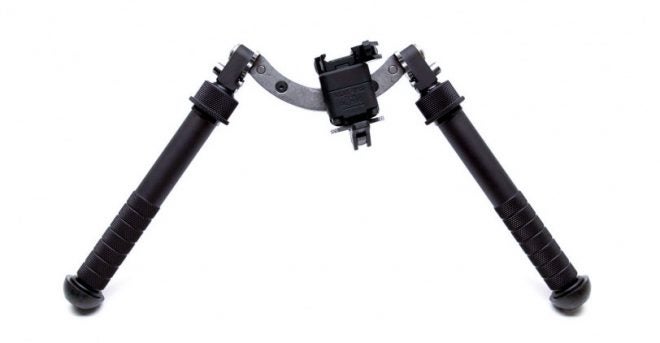Bipods, a simple construction with two legs to support your rifle and hopefully help you make a better shot. But also what sets men and shooters apart, and drains wallets.
The subject of bipods could have ended quickly. There are fully functional bipods for 40-50 Dollars, but then someone had to make them in carbon fiber and others made high-end versions for over 500 Dollars.
For practical rifle shooting I’ve been using different versions of the Harris bipods, with the La Rue Tactical Picatinny adapter (LaRue Tactical Harris Bipod Adapter LT130).
A few years ago I started using the B&T Industries Atlas PSR bipod, and it’s great (in fact, indispensable) for some situations. I still prefer the Harris ones in other places.

At the end of the 2016 season I bought myself the Nord Arms (Made in Estonia) bipods in carbon fibre, with quick attach and long legs (for kneeling position). They seem great too, and very light, but I haven’t used them enough to write an evaluation yet.They are priced to be affordable at around 200-250 Euros.
So as you can imagine, you just don’t buy one bipod – you have a house full of them. Choosing the right bipod is just as hard as choosing a muzzle brake or compensator, but there are probably less brands to choose from.
Review: 5-H Atlas Bipod BT35-LW17
Ever since the new Atlas 5-H bipod was released I’ve been looking at it, but the price has refrained me from buying. It also looked a little too heavy for practical rifle competition.
But as I bought a Ruger Precision Rifle and wanted to improve on my long range shooting skills, the 5-H bipod looked more and more attractive so I succeeded in talking myself into buying one.

In fact, from telling myself “they are crazy expensive – go away!“, I managed to persuade myself that I probably must have them. Sometime all you need is a little time.

These words don’t come easy, but having opened the box, examined the content I have to say that the price is easier to digest. (but there’s also a lot of dollars to digest)
Whenever I buy quality stuff, whether it be optics or accessories, I rarely regret going for “gold” and I think it’s better to buy what you want instead of buying something half-ways and end up selling it. The 5-H (and PSR for that matter) gives you a solid quality feel, without feeling over-engineered.
If I bought a counterfeit which failed on me during a competition, I don’t know if I could live with myself. Also, getting the real thing gives you an assurance which helps in your mental preparedness. I wouldn’t fly or drive to the competition in a counterfeit transport to save some money, would I?
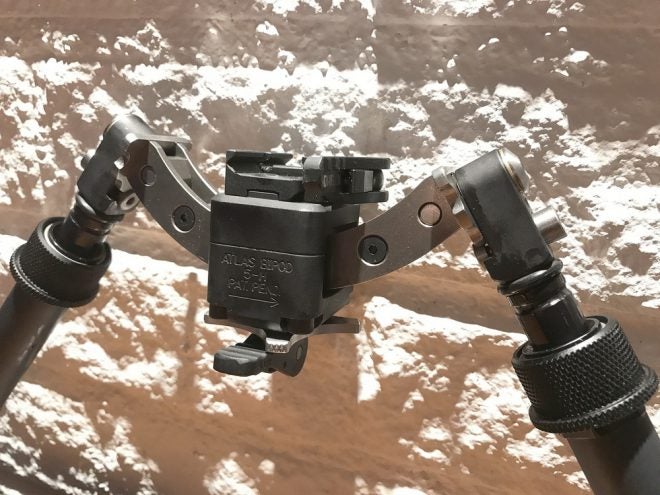
I have tested the Atlas 5-H on the Ruger Precision Rifle, Troy PAR 16″ and a JP Enterprises CTR-02 (competition AR-15).
The 5-H mounts directly to your Picatinny rail via the quick attach, which I believe is made by American Defense. This makes mounting the bipod fast and easy.
You can pan and cant the firearm +/- 15 degrees. One of the reasons I bought the 5-H, was that I wanted my rifle to auto-cant almost wherever I put my rifle. In both practical shooting, where time counts, and precision shooting it’s not always possible to choose a shooting position where the ground is even and if your rifle is tilted it will affect the hit.

Atlas 5-H on a Ruger Precision Rifle in .308 Win, with ASE Utra suppressor and BoreLok.
I imagined that the canting function would be almost like on ball bearings, but there’s more friction than that, and although it’s not what I expected it’s probably a good thing, helping in making the bipod more stable. Your rifle is not hanging loose, just fairly loose.
For most of my shooting I keep the cant and pan function as open as possible, but there is a possibility to tighten this function and add more friction. There is also a full stop detent.
As it turns out, I now appreciate the panning function – it’s excellent! I can easily cover targets from far left to far right on a 30+ position wide shooting range, without having to change the position of the legs. Obviously, your body might have to move to keep a good shooting position and eye-box.
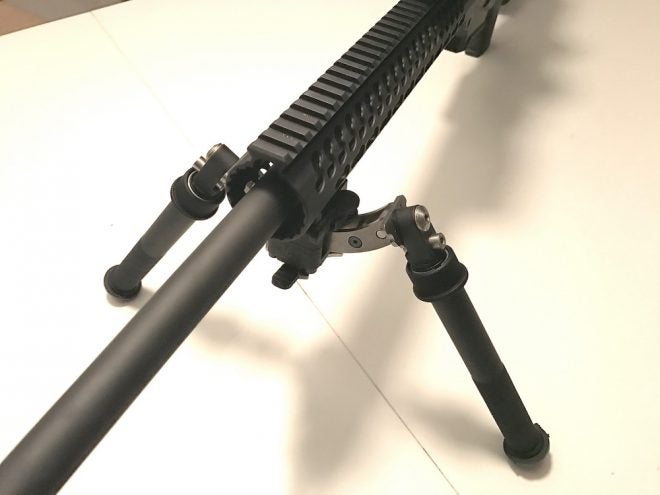
The length of the legs is adjustable, and will give you a range of around 5.5″ – 10.5″. Not enough for a kneeling shooting position, there are other bipods for that.
Pictured below: As the leg positions are individually fixed in either 0, 45, 90, 135 and 180 degrees this opens up for some out of the ordinary supports. You may think I’m never going to use this, but I’ve had some situations in competition where I and the team used the Atlas PSR bipod like we couldn’t use a standard Harris pod. For instance if you want to go really low, with a short magazine, or where the support is tilted 45 degrees but you really, really want some support for your barrel. Even in a situation like below, the legs and construction of the Atlas gives you a really steady support. Nothing is flimsy and you can apply some force to help your shooting. And remember, with a Picatinny, you can have the bipod mounted much closer to the receiver than this and just stick your handguard and barrel out.

I have used the 5-H on a Troy PAR as well. The PAR is a 16″ .223 Rem, and a pump-action AR-15 style. Yes, it’s been modified. Zeiss V8 1.1-8x in a Spuhr mount.
The benefit with the 5-H is that it will “flatten” the rifle horizontally after the pump action, and it’s extremely stable during the pump movement and shooting. Target transition is very easy, and the legs stay where you put them.
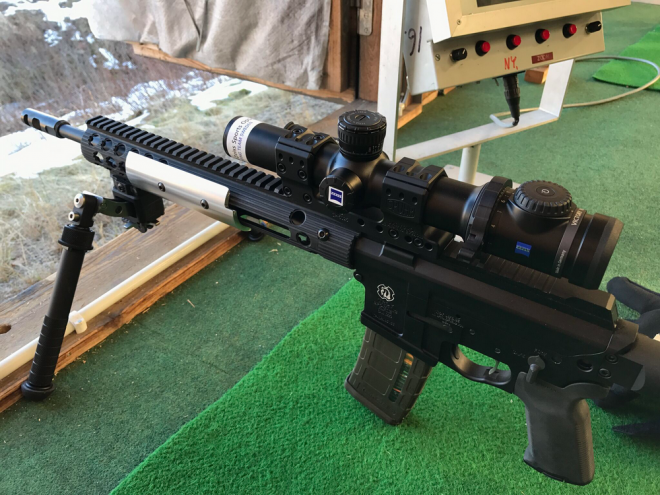
This Atlas will add 26 ounces (740 grams) to your system. That’s quite a lot and most likely not something I would add to my backpack if I went out hiking for a week. For shorter distances I don’t really see the weight as a problem. On the contrary, the mass and the ruggedness of the Atlas will reduce recoil.
There is also a version called 5-H Atlas Bipod BT35-NC, which is a no clamp version that will not attach to a Picatinny rail.
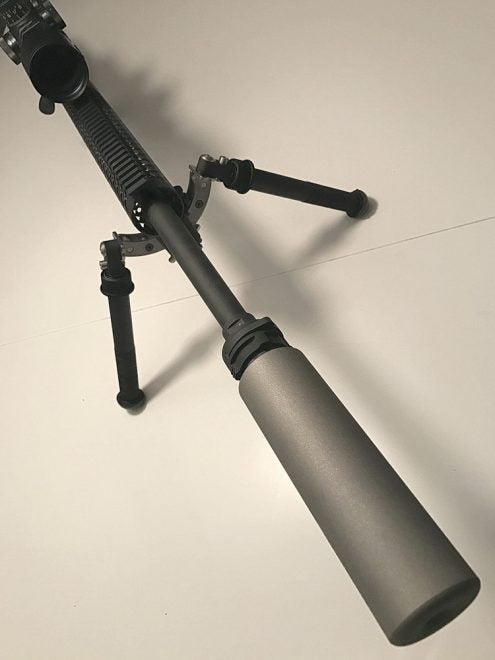
For the record, please beware that the Atlas bipods are made by B&T Industries L.L.C. (USA) and not B&T from Switzerland.
I have probably forgotten a lot of things, but let’s sum it up:
PROS
State-of-the-art bipod.
Very robust design and engineering, innovative.
Heavy – will not move easily, reduces recoil.
Excellent panning and good canting.
Attracts attention (jealousy) and “tech talk”.
Made in the USA
CONS
Not on the cheap side, but still good value for your money.
Heavy – unless you have a caddy.
If you don’t like attention and getting questions at the shooting range, don’t get one.
I understand that a lot of people will never spend as much on a shooting accessory, but if you can afford them I highly recommend the Atlas bipods.
Below: Beware of copies. This sticker comes in the box. I guess B&T Industries are sick and tired of having their design stolen. They offer a a $25.00 dollar credit towards a purchase of an original: https://www.accu-shot.com/Wright_Project.php

Folded Atlas 5-H besides a folded Atlas PSR. The PSR has the optional BT-24 Cleats mounted, which I look forward to evaluate. These accessories will not fit the 5-H, as you can see the legs are much thicker than the normal Atlas.
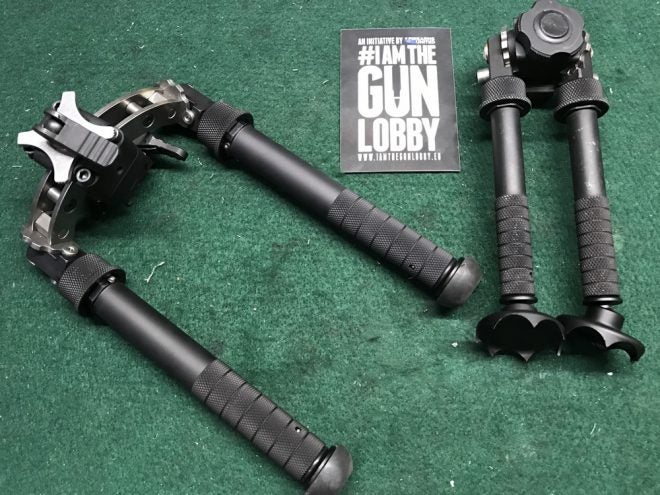
For the record I bought the 5-H bipod I evaluated from my local dealer.
 Your Privacy Choices
Your Privacy Choices
